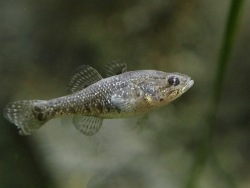The Primorsky Aquarium-bred Amur sleepers make their debut in the exhibit

Amur sleepers bred at the Primorsky Aquarium have been transferred from the Science and Acclimation Building to the Exhibit Building. The young-of-the-year are making themselves at home in the themed tank with hibernating fishes.
“Earlier this year, in February, we hatched a brood of the Amur sleeper — it is the first recorded captive breeding of this small predatory fish for public aquariums,” said Lyubov Petrova, Senior Specialist at the Department of the Russian Far East Freshwater Organisms. “The parents were caught in a lakelet near Slavyanka (translator’s note – a small town in southern Primorye). When they finished spawning, we almost immediately relocated the eggs to a separate tank. We did it for a few reasons. Firstly, it was important for us to observe all developmental stages of the eggs. Secondly, though male Amur sleepers carefully guard their eggs driving away all those who wish to eat them, right after hatching the parental instinct fades away, and larvae can fall prey to their own father.”
“Some 50 larvae hatched from the eggs, the separate tank was placed in our room, and each member of our Department staff took part in their raising, fed them, added water to the tank, monitored the temperature and oxygen concentration. These are our collective “children”, our pride,” explained Tatiana Yurova, Lead Specialist at the Department of the Russian Far East Freshwater Organisms.
The most essential aspect in rearing of fry is special food which is provided by the Live Foods Section of the Primorsky Aquarium. Biologists meticulously developed a diet for the growing fish.
“At first, we fed the Amur sleepers with desalted rotifers,” said Anna Kozmina, Lead Specialist at the Department of the Russian Far East Freshwater Organisms. “Later on, brine shrimp was added to their menu: at first, it was offered in the form of decapsulated eggs suitable for baby fish, and then the fry were gradually switched to adult specimens. At present, they are old enough to consume bloodworm, scallop and fish chopped into small pieces.”
Twenty young Amur sleepers have gone on display in the Aquarium's exhibit. Now they feel comfortable in a moderate-size tank but their separation is inevitable – when Amur sleepers are juvenile, they get along well with each other but while aging males start fighting over territory and females.
According to the aquarists, future “leaders” can be seen even now: during feedings bolder individuals chase away the others. The species reaches sexual maturity in the second year of life, and the biologists hope that the Aquarium-bred Amur sleepers will reproduce.
General Information:
— The Amur sleeper is native to the Amur River basin but in the 20th century it was accidentally introduced into waterbodies in central Russia where it became invasive and suppressed some indigenous species.
— In winter, Amur sleepers hibernate, they can also withstand severe frosts due to salts that accumulate in their perivisceral fluid towards autumn and serve as natural “antifreeze”.
—Because of its tolerance to low dissolved oxygen levels, the Amur sleeper can survive the drying out of its habitat by taking shelter in its mucus cocoon or digging itself into mud.
—Amur sleepers are ambush predators.
—During breeding period the appearance of male Amur sleepers changes: they develop a cap-like hump on the head, and their fins turn brighter.